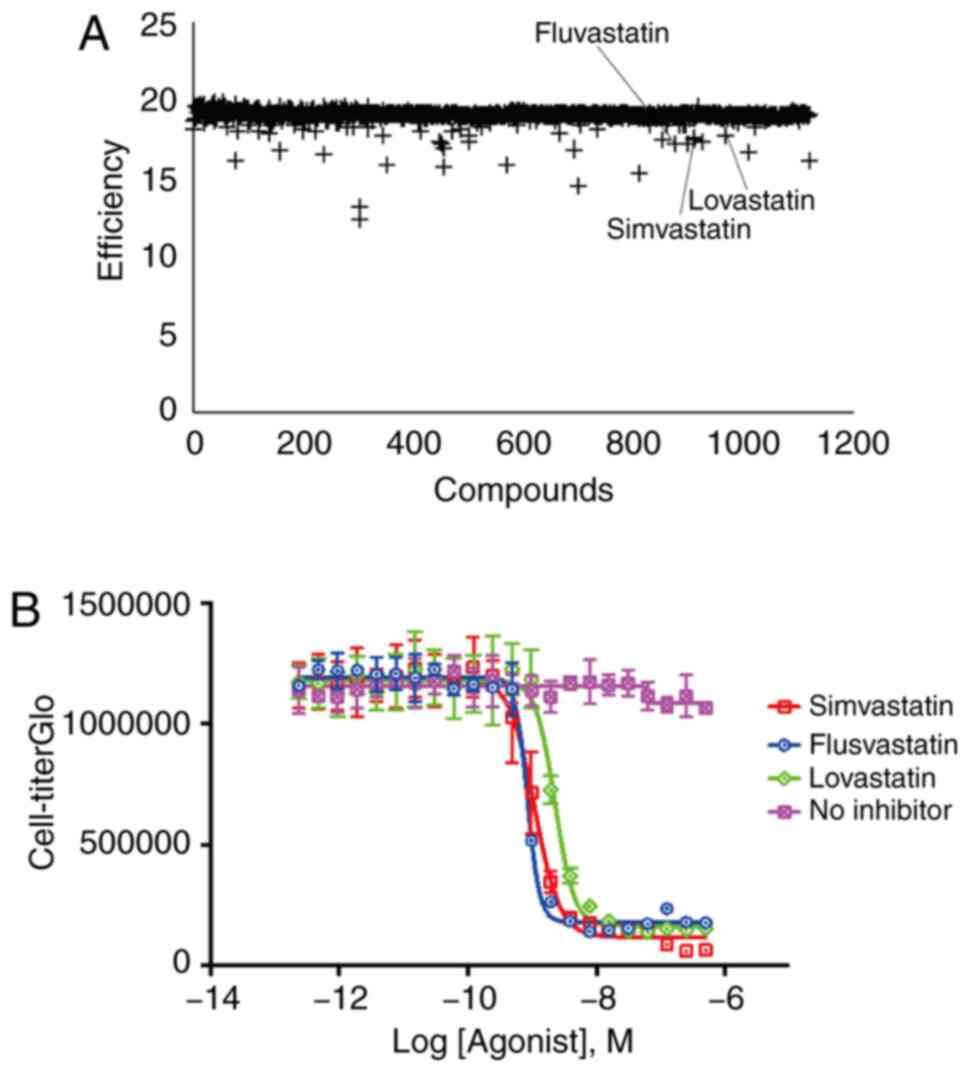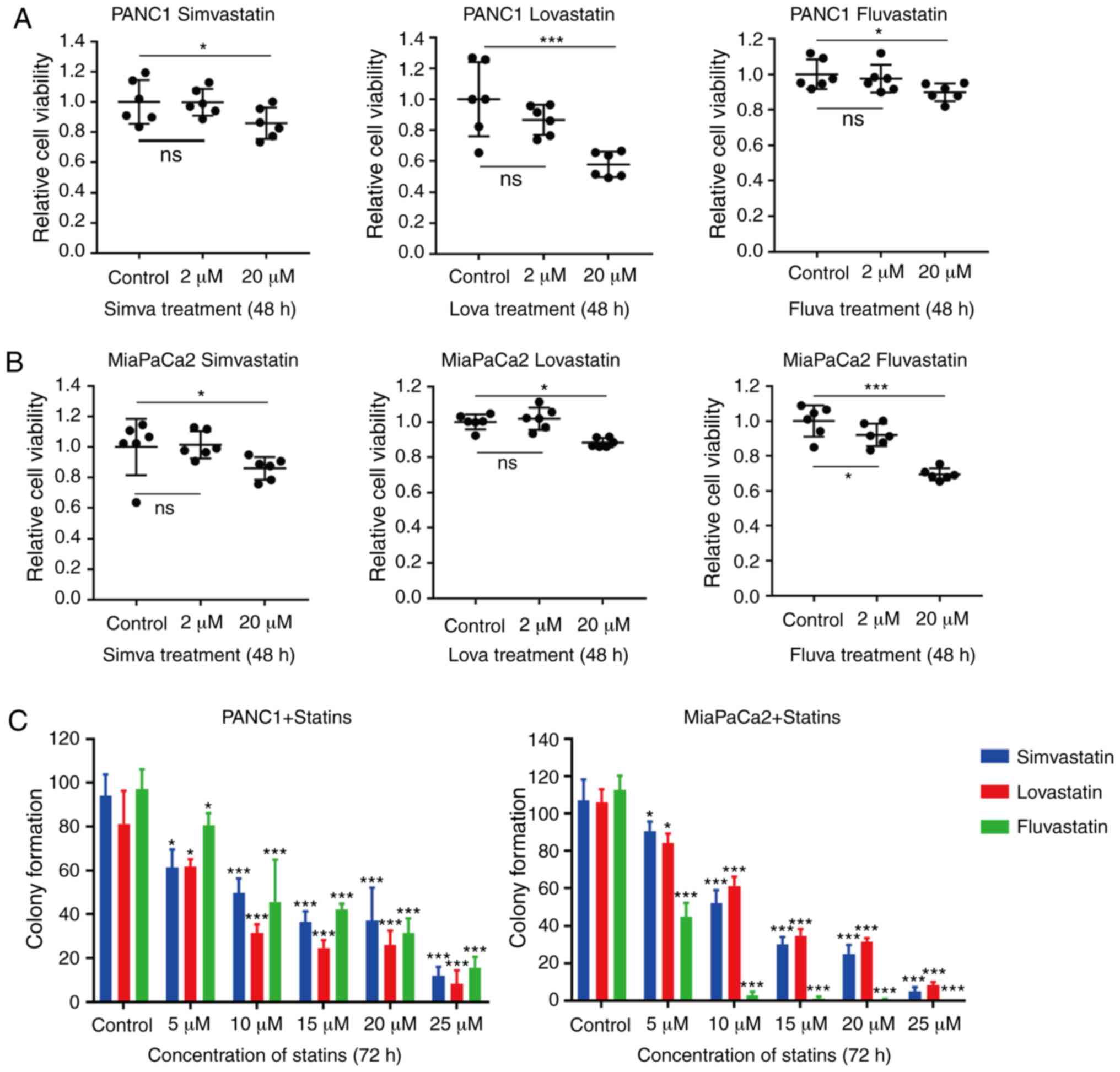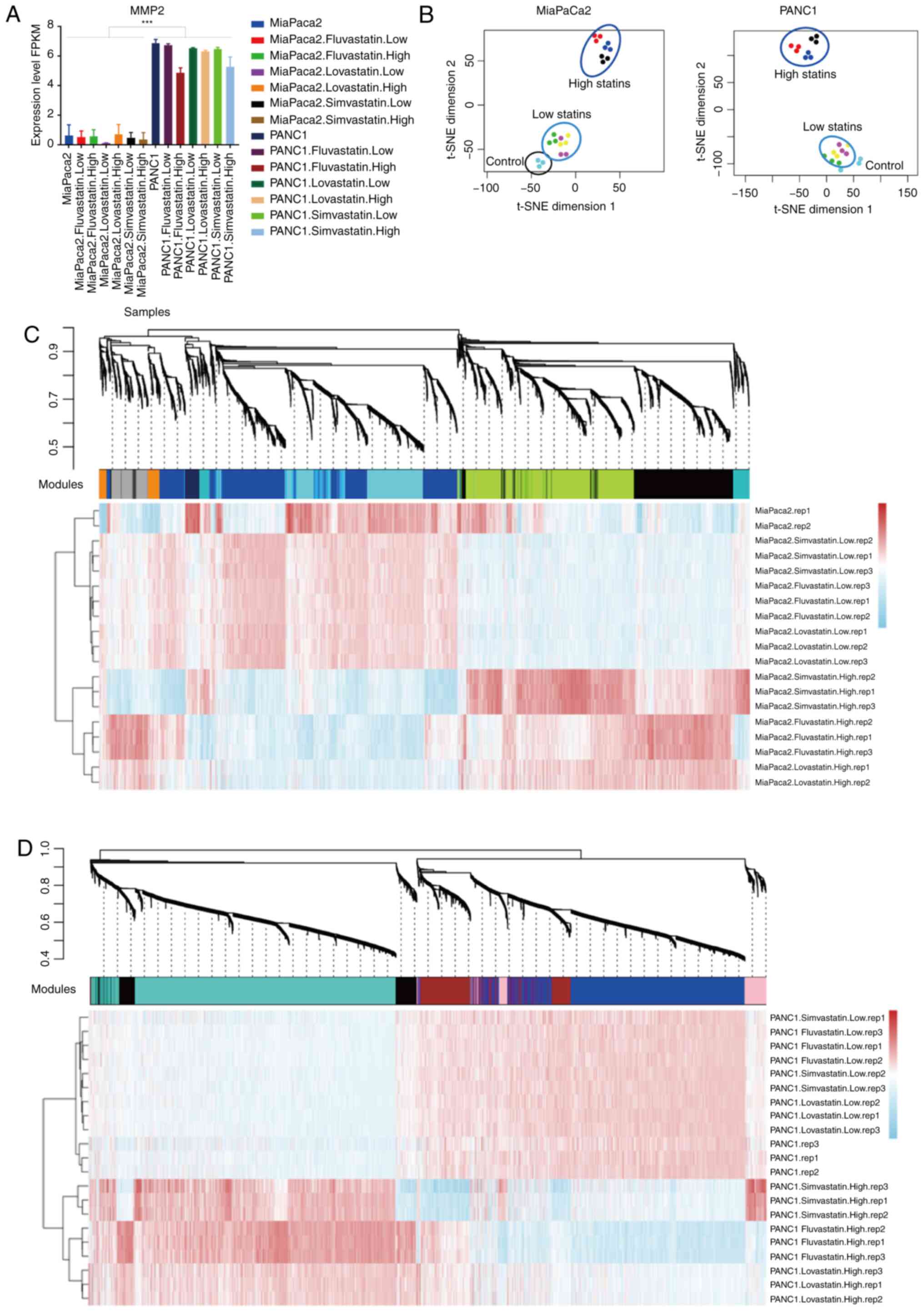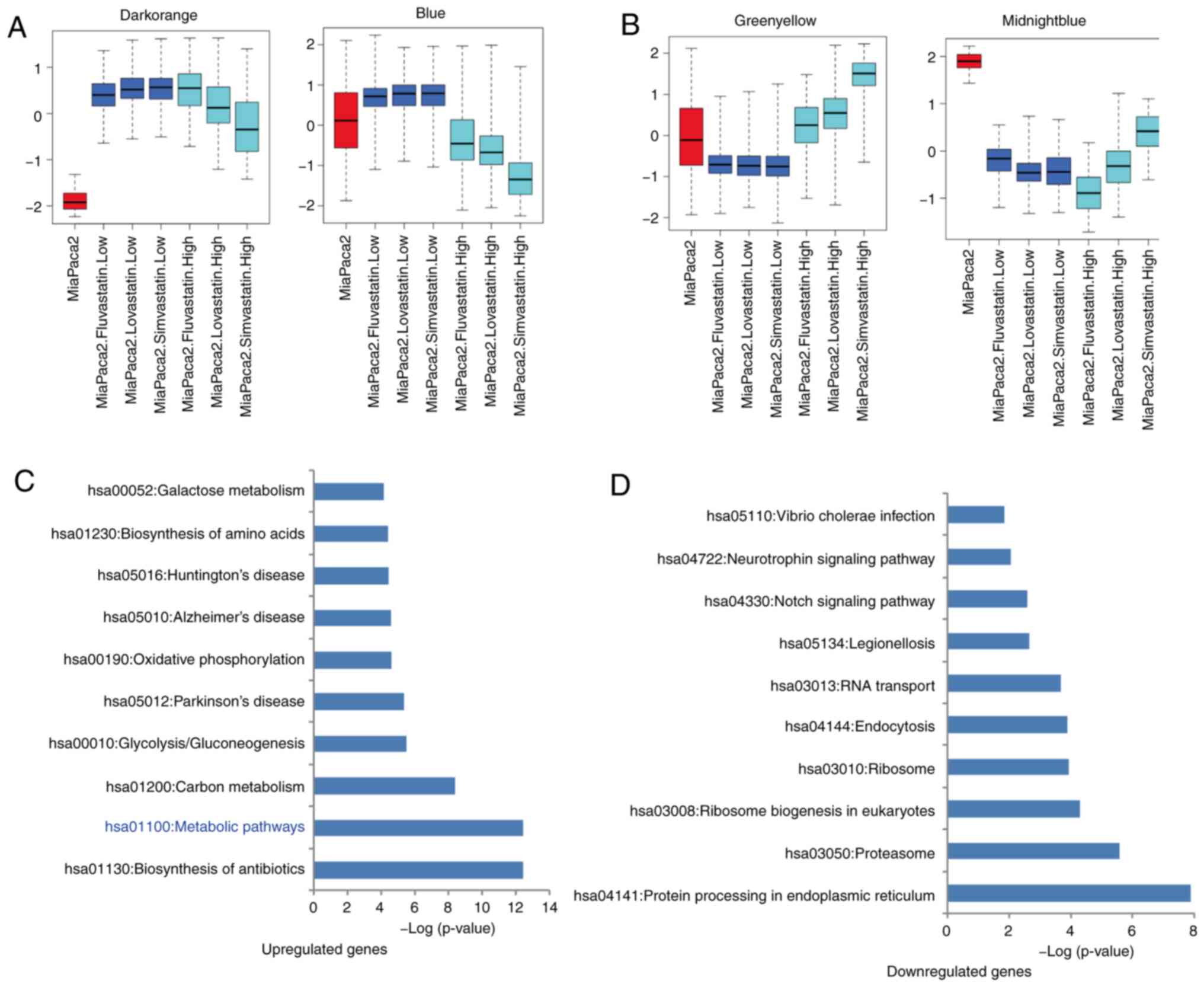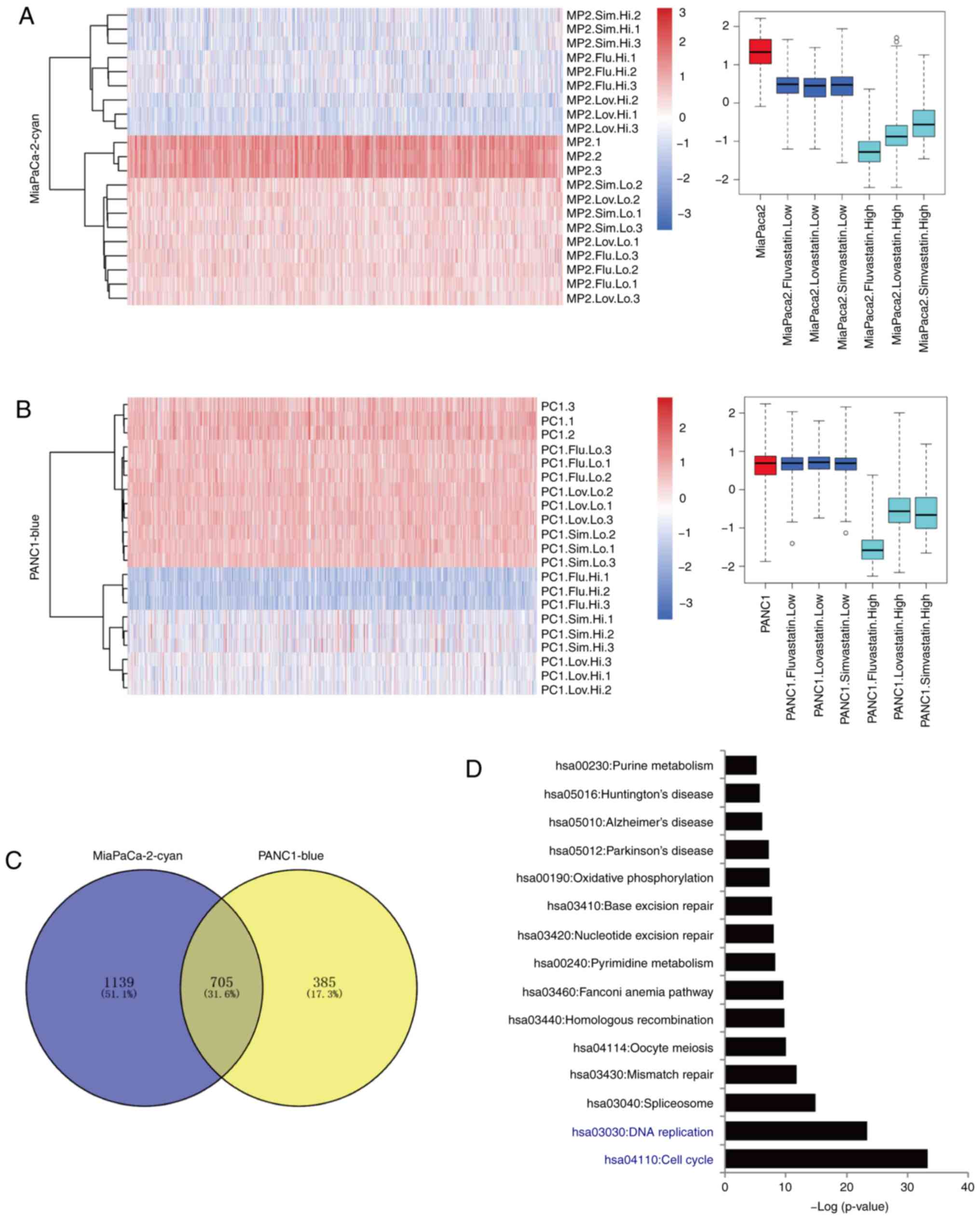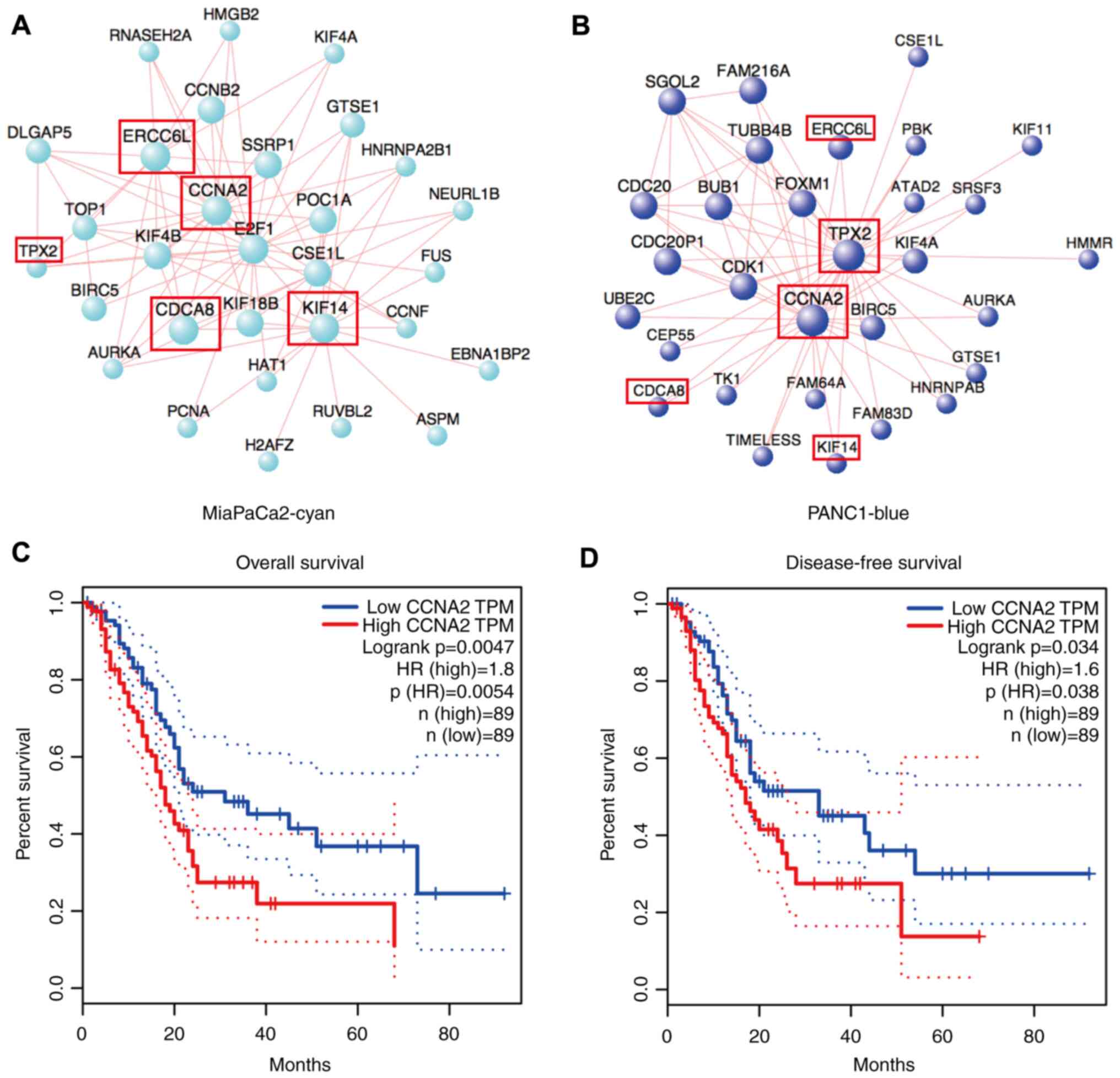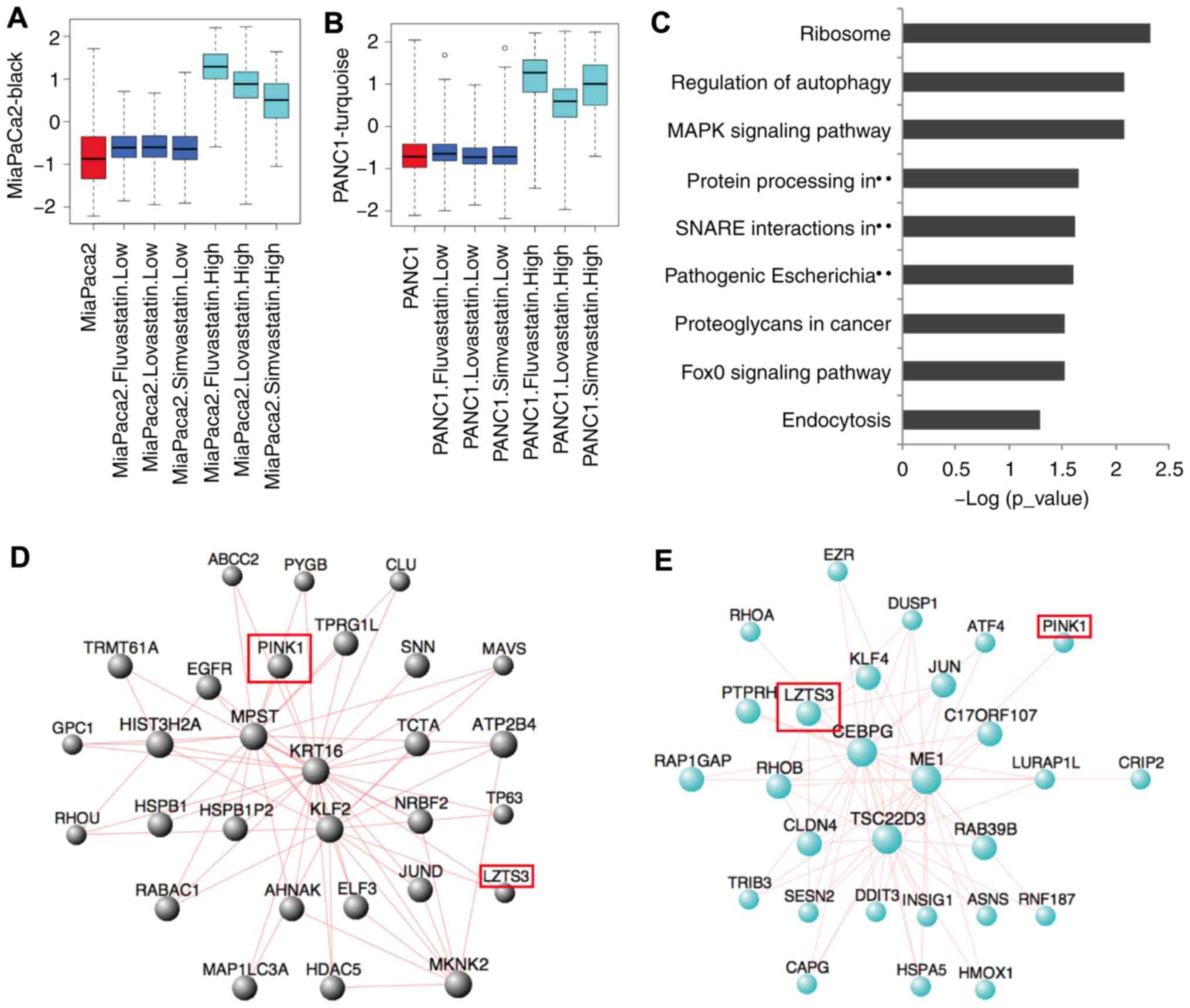|
1
|
Rahib L, Smith BD, Aizenberg R, Rosenzweig
AB, Fleshman JM and Matrisian LM: Projecting cancer incidence and
deaths to 2030: The unexpected burden of thyroid, liver, and
pancreas cancers in the United States. Cancer Res. 74:2913–2921.
2014. View Article : Google Scholar : PubMed/NCBI
|
|
2
|
Hamada T, Khalaf N, Yuan C, Babic A,
Morales-Oyarvide V, Qian ZR, Nowak JA, Ng K, Kraft P, Rubinson DA,
et al: Statin use and pancreatic cancer risk in two prospective
cohort studies. J Gastroenterol. 53:959–966. 2018. View Article : Google Scholar : PubMed/NCBI
|
|
3
|
Oprea TI and Mestres J: Drug repurposing:
Far beyond new targets for old drugs. AAPS J. 14:759–763. 2012.
View Article : Google Scholar : PubMed/NCBI
|
|
4
|
Zhang Y, Liang M, Sun C, Qu G, Shi T, Min
M, Wu Y and Sun Y: Statin use and risk of pancreatic cancer: An
updated meta-analysis of 26 studies. Pancreas. 48:142–150. 2019.
View Article : Google Scholar : PubMed/NCBI
|
|
5
|
Mitchell JD, Fergestrom N, Gage BF,
Paisley R, Moon P, Novak E, Cheezum M, Shaw LJ and Villines TC:
Impact of statins on cardiovascular outcomes following coronary
artery calcium scoring. J Am Coll Cardiol. 72:3233–3242. 2018.
View Article : Google Scholar : PubMed/NCBI
|
|
6
|
Mohammadkhani N, Gharbi S, Rajani HF,
Farzaneh A, Mahjoob G, Hoseinsalari A and Korsching E: Statins:
Complex outcomes but increasingly helpful treatment options for
patients. Eur J Pharmacol. 863:1727042019. View Article : Google Scholar : PubMed/NCBI
|
|
7
|
Tamburrino D, Crippa S, Partelli S,
Archibugi L, Arcidiacono PG, Falconi M and Capurso G: Statin use
improves survival in patients with pancreatic ductal
adenocarcinoma: A meta-analysis. Dig Liver Dis. 52:392–399. 2020.
View Article : Google Scholar : PubMed/NCBI
|
|
8
|
Huang SW, Chyuan IT, Shiue C, Yu MC, Hsu
YF and Hsu MJ: Lovastatin-mediated MCF-7 cancer cell death involves
LKB1-AMPK-p38MAPK-p53-survivin signalling cascade. J Cell Mol Med.
24:1822–1836. 2020. View Article : Google Scholar : PubMed/NCBI
|
|
9
|
Xian G, Zhao J, Qin C, Zhang Z, Lin Y and
Su Z: Simvastatin attenuates macrophage-mediated gemcitabine
resistance of pancreatic ductal adenocarcinoma by regulating the
TGF-β1/Gfi-1 axis. Cancer Lett. 385:65–74. 2017. View Article : Google Scholar : PubMed/NCBI
|
|
10
|
Kanvatirth P, Jeeves RE, Bacon J, Besra GS
and Alderwick LJ: Utilisation of the Prestwick chemical library to
identify drugs that inhibit the growth of mycobacteria. PLoS One.
14:e02137132019. View Article : Google Scholar : PubMed/NCBI
|
|
11
|
Moreau D, Vacca F, Vossio S, Scott C,
Colaco A, Paz Montoya J, Ferguson C, Damme M, Moniatte M, Parton
RG, et al: Drug-induced increase in lysobisphosphatidic acid
reduces the cholesterol overload in Niemann-Pick type C cells and
mice. EMBO Rep. 20:e470552019. View Article : Google Scholar : PubMed/NCBI
|
|
12
|
Livak KJ and Schmittgen TD: Analysis of
relative gene expression data using real-time quantitative PCR and
the 2(-Delta Delta C(T)) method. Methods. 25:402–408. 2001.
View Article : Google Scholar : PubMed/NCBI
|
|
13
|
Brown J, Pirrung M and McCue LA: FQC
Dashboard: Integrates FastQC results into a web-based, interactive,
and extensible FASTQ quality control tool. Bioinformatics.
33:3137–3139. 2017. View Article : Google Scholar : PubMed/NCBI
|
|
14
|
Bolger AM, Lohse M and Usadel B:
Trimmomatic: A flexible trimmer for Illumina sequence data.
Bioinformatics. 30:2114–2120. 2014. View Article : Google Scholar : PubMed/NCBI
|
|
15
|
Phan L, Hsu J, Tri LQ, Willi M, Mansour T,
Kai Y, Garner J, Lopez J and Busby B: dbVar structural variant
cluster set for data analysis and variant comparison. F1000Res.
5:6732016. View Article : Google Scholar : PubMed/NCBI
|
|
16
|
Trapnell C, Pachter L and Salzberg SL:
TopHat: Discovering splice junctions with RNA-Seq. Bioinformatics.
25:1105–1111. 2009. View Article : Google Scholar : PubMed/NCBI
|
|
17
|
Wu H, Yu J, Li Y, Hou Q, Zhou R, Zhang N,
Jing Z, Jiang M, Li Z, Hua Y, et al: Single-cell RNA sequencing
reveals diverse intratumoral heterogeneities and gene signatures of
two types of esophageal cancers. Cancer Lett. 438:133–143. 2018.
View Article : Google Scholar : PubMed/NCBI
|
|
18
|
Huang da W, Sherman BT and Lempicki RA:
Systematic and integrative analysis of large gene lists using DAVID
bioinformatics resources. Nat Protoc. 4:44–57. 2009. View Article : Google Scholar : PubMed/NCBI
|
|
19
|
Huang da W, Sherman BT and Lempicki RA:
Bioinformatics enrichment tools: Paths toward the comprehensive
functional analysis of large gene lists. Nucleic Acids Res.
37:1–13. 2009. View Article : Google Scholar : PubMed/NCBI
|
|
20
|
Tang Z, Li C, Kang B, Gao G, Li C and
Zhang Z: GEPIA: A web server for cancer and normal gene expression
profiling and interactive analyses. Nucleic Acids Res. 45((W1)):
W98–W102. 2017. View Article : Google Scholar : PubMed/NCBI
|
|
21
|
Wheatley SP and Altieri DC: Survivin at a
glance. J Cell Sci. 132:jcs2238262019. View Article : Google Scholar : PubMed/NCBI
|
|
22
|
Liu SH, Hong Y, Markowiak S, Sanchez R,
Creeden J, Nemunaitis J, Kalinoski A, Willey J, Erhardt P, Lee J,
et al: BIRC5 is a target for molecular imaging and detection of
human pancreatic cancer. Cancer Lett. 457:10–19. 2019. View Article : Google Scholar : PubMed/NCBI
|
|
23
|
Schultz RM, Merriman RL, Toth JE,
Zimmermann JE, Hertel LW, Andis SL, Dudley DE, Rutherford PG,
Tanzer LR and Grindey GB: Evaluation of new anticancer agents
against the MIA PaCa-2 and PANC-1 human pancreatic carcinoma
xenografts. Oncol Res. 5:223–228. 1993.PubMed/NCBI
|
|
24
|
Okada Y, Eibl G, Guha S, Duffy JP, Reber
HA and Hines OJ: Nerve growth factor stimulates MMP-2 expression
and activity and increases invasion by human pancreatic cancer
cells. Clin Exp Metastasis. 21:285–292. 2004. View Article : Google Scholar : PubMed/NCBI
|
|
25
|
McGlynn KA, Hagberg K, Chen J, Graubard
BI, London WT, Jick S and Sahasrabuddhe VV: Statin use and risk of
primary liver cancer in the clinical practice research datalink. J
Natl Cancer Inst. 107:djv0092015. View Article : Google Scholar : PubMed/NCBI
|
|
26
|
Yu O, Eberg M, Benayoun S, Aprikian A,
Batist G, Suissa S and Azoulay L: Use of statins and the risk of
death in patients with prostate cancer. J Clin Oncol. 32:5–11.
2014. View Article : Google Scholar : PubMed/NCBI
|
|
27
|
Murtola TJ, Visvanathan K, Artama M,
Vainio H and Pukkala E: Statin use and breast cancer survival: A
nationwide cohort study from Finland. PLoS One. 9:e1102312014.
View Article : Google Scholar : PubMed/NCBI
|
|
28
|
Paškevičiūtė M and Petrikaitė V:
Differences of statin activity in 2D and 3D pancreatic cancer cell
cultures. Drug Des Devel Ther. 11:3273–3280. 2017. View Article : Google Scholar : PubMed/NCBI
|
|
29
|
Ghaneh P, Costello E and Neoptolemos JP:
Biology and management of pancreatic cancer. Gut. 56:1134–1152.
2007.PubMed/NCBI
|
|
30
|
Archibugi L, Arcidiacono PG and Capurso G:
Statin use is associated to a reduced risk of pancreatic cancer: A
meta-analysis. Dig Liver Dis. 51:28–37. 2019. View Article : Google Scholar : PubMed/NCBI
|
|
31
|
Jian-Yu E, Graber JM, Lu SE, Lin Y, Lu-Yao
G and Tan XL: Effect of metformin and statin use on survival in
pancreatic cancer patients: A systematic literature review and
meta-analysis. Curr Med Chem. 25:2595–2607. 2018. View Article : Google Scholar : PubMed/NCBI
|
|
32
|
Simon MS, Desai P, Wallace R, Wu C, Howard
BV, Martin LW, Schlecht N, Liu S, Jay A, LeBlanc ES, et al:
Prospective analysis of association between statins and pancreatic
cancer risk in the Women's Health Initiative. Cancer Causes
Control. 27:415–423. 2016. View Article : Google Scholar : PubMed/NCBI
|
|
33
|
Lee HS, Lee SH, Lee HJ, Chung MJ, Park JY,
Park SW, Song SY and Bang S: Statin use and its impact on survival
in pancreatic cancer patients. Medicine (Baltimore). 95:e36072016.
View Article : Google Scholar : PubMed/NCBI
|
|
34
|
Wu BU, Chang J, Jeon CY, Pandol SJ, Huang
B, Ngor EW, Difronzo AL and Cooper RM: Impact of statin use on
survival in patients undergoing resection for early-stage
pancreatic cancer. Am J Gastroenterol. 110:1233–1239. 2015.
View Article : Google Scholar : PubMed/NCBI
|
|
35
|
Walker EJ, Ko AH, Holly EA and Bracci PM:
Statin use and risk of pancreatic cancer: Results from a large,
clinic-based case-control study. Cancer. 121:1287–1294. 2015.
View Article : Google Scholar : PubMed/NCBI
|
|
36
|
Jeon CY, Pandol SJ, Wu B, Cook-Wiens G,
Gottlieb RA, Merz CN and Goodman MT: The association of statin use
after cancer diagnosis with survival in pancreatic cancer patients:
A SEER-medicare analysis. PLoS One. 10:e01217832015. View Article : Google Scholar : PubMed/NCBI
|
|
37
|
Hong JY, Nam EM, Lee J, Park JO, Lee SC,
Song SY, Choi SH, Heo JS, Park SH, Lim HY, et al: Randomized
double-blinded, placebo-controlled phase II trial of simvastatin
and gemcitabine in advanced pancreatic cancer patients. Cancer
Chemother Pharmacol. 73:125–130. 2014. View Article : Google Scholar : PubMed/NCBI
|
|
38
|
Murai T: Cholesterol lowering: Role in
cancer prevention and treatment. Biol Chem. 396:1–11. 2015.
View Article : Google Scholar : PubMed/NCBI
|
|
39
|
Bahrami A, Parsamanesh N, Atkin SL, Banach
M and Sahebkar A: Effect of statins on toll-like receptors: A new
insight to pleiotropic effects. Pharmacol Res. 135:230–238. 2018.
View Article : Google Scholar : PubMed/NCBI
|
|
40
|
Wu F, Luo T, Mei Y, Liu H, Dong J, Fang Y,
Peng J and Guo Y: Simvastatin alters M1/M2 polarization of murine
BV2 microglia via Notch signaling. J Neuroimmunol. 316:56–64. 2018.
View Article : Google Scholar : PubMed/NCBI
|
|
41
|
Zacharek A, Chen J, Cui X, Yang Y and
Chopp M: Simvastatin increases notch signaling activity and
promotes arteriogenesis after stroke. Stroke. 40:254–260. 2009.
View Article : Google Scholar : PubMed/NCBI
|
|
42
|
Verhulst A, D'Haese PC and De Broe ME:
Inhibitors of HMG-CoA reductase reduce receptor-mediated
endocytosis in human kidney proximal tubular cells. J Am Soc
Nephrol. 15:2249–2257. 2004. View Article : Google Scholar : PubMed/NCBI
|
|
43
|
Sidaway JE, Davidson RG, McTaggart F,
Orton TC, Scott RC, Smith GJ and Brunskill NJ: Inhibitors of
3-hydroxy-3-methylglutaryl-CoA reductase reduce receptor-mediated
endocytosis in opossum kidney cells. J Am Soc Nephrol.
15:2258–2265. 2004. View Article : Google Scholar : PubMed/NCBI
|
|
44
|
Jain RK: Barriers to drug delivery in
solid tumors. Sci Am. 271:58–65. 1994. View Article : Google Scholar : PubMed/NCBI
|
|
45
|
DeGorter MK, Tirona RG, Schwarz UI, Choi
YH, Dresser GK, Suskin N, Myers K, Zou G, Iwuchukwu O, Wei WQ, et
al: Clinical and pharmacogenetic predictors of circulating
atorvastatin and rosuvastatin concentrations in routine clinical
care. Circ Cardiovasc Genet. 6:400–408. 2013. View Article : Google Scholar : PubMed/NCBI
|
|
46
|
Qin C, Yang G, Yang J, Ren B, Wang H, Chen
G, Zhao F, You L, Wang W and Zhao Y: Metabolism of pancreatic
cancer: Paving the way to better anticancer strategies. Mol Cancer.
19:502020. View Article : Google Scholar : PubMed/NCBI
|
|
47
|
Sousa CM and Kimmelman AC: The complex
landscape of pancreatic cancer metabolism. Carcinogenesis.
35:1441–1450. 2014. View Article : Google Scholar : PubMed/NCBI
|
|
48
|
Biancur DE and Kimmelman AC: The
plasticity of pancreatic cancer metabolism in tumor progression and
therapeutic resistance. Biochim Biophys Acta Rev Cancer.
1870:67–75. 2018. View Article : Google Scholar : PubMed/NCBI
|
|
49
|
Hermann PC and Sainz B Jr: Pancreatic
cancer stem cells: A state or an entity? Semin Cancer Biol.
53:223–231. 2018. View Article : Google Scholar : PubMed/NCBI
|
|
50
|
New M and Tooze S: The role of autophagy
in pancreatic cancer-recent advances. Biology (Basel). 9:72019.
|















